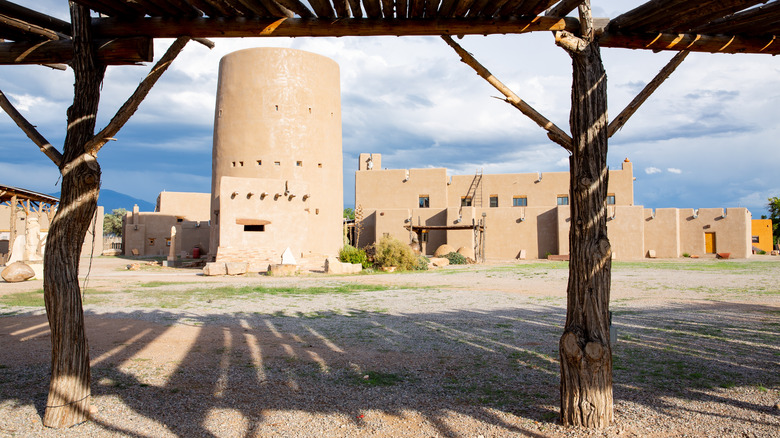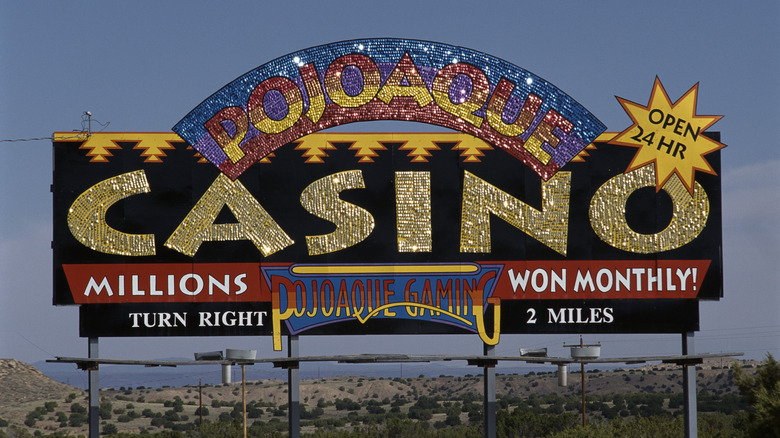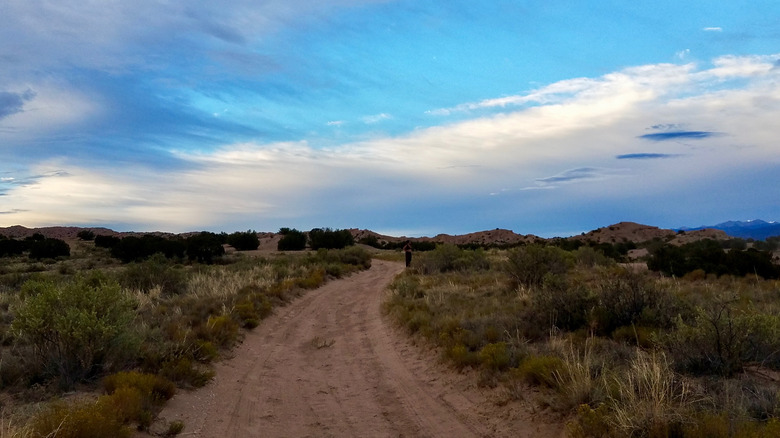Just North Of Santa Fe Is New Mexico's Fascinating Destination With Casinos, Sacred Art, And Adventure
It only takes a casual glance at a map of New Mexico to see that the state is filled with Native American lands, like the Cochiti near the spires of Kasha-Katuwe Tent Rocks National Monument. New Mexico is home to 23 tribes, in fact, 19 of which are Pueblos — Indigenous people of a 7,000-year-old lineage that share their name with their characteristic adobe brick architecture. Eight such tribes live in communities right along the 70-mile strip of Route 84 between Santa Fe and Taos. One of these, the Pojoaque, offers visitors a unique chance to step into a past-meets-present space of full of as much art and culture as it is adventure and entertainment.
Judging by archaeological records, the Pojoaque settled in modern-day New Mexico about 500 C.E. Part of a group of Tewa-speaking peoples, their name was originally pronounced "Po-suwae-geh," which meant the "water drinking/gathering place." The Pojoaque endured an influx of people from the Apache and Navajo tribes in the 1400s, Spanish settlers in the 1500s through the 1600s, and got swept up in America's Westward Expansion in the 1800s that ended in the 1934 Indian Reorganization Act. This act essentially handed native sovereignty back to tribespeople on their own grounds. Now, the Pojoaque equal about 500 people spread over 12,000 acres.
It's this history and culture into which visitors to Pojoaque Pueblo can step. The memorable Poeh Cultural Center & Museum sits at the center of any visit to Pojoaque, a part-museum, part-event center built in the style of traditional adobe structures. Its eye-opening access to Pojoaque heritage is balanced out by the pueblo's Cities of Gold Casino and Buffalo Thunder Resort Casino, as well as load of outdoor adventures waiting at your fingertips, including hiking, camping, and white water rafting.
Ancient art and history meets new entertainment at Pojoaque Pueblo
Witbout a doubt, the heart of Pojoaque Pueblo lives at the Poeh Cultural and Museum Center. To tribespeople and non-tribespeople alike, the 1,600-square-foot center is a place to learn about Pojoaque language, intangible artifacts like song and dance, and physical crafts like textiles, pottery, and jewelry. Established in 1988 and built using traditional adobe — mud brick mixed with clay and straw — the center acts as a repository for Pojoaque culture in the form of Tewa pottery returned from the Smithsonian in 2019. It has an annual farmer's market, teaches Pojoaque hoop dancing, and hosts an indoor market at the nearby Buffalo Thunder Resort Casino every Friday through Sunday. It also hosts the Pathways Indigenous Arts Festival at the same casino featuring 400 different artists.
And speaking of casinos, the Pojoaque have opted for the same revenue-earning route as many other tribes, like the Pima-Maricopa-owned Casino Arizona. However, Pojoaque Pueblo has two options for visitors less than a 10-minute drive from each other, both of which double up as hotels. As soon as you've had your fill of cultural education, and possibly some Mexican food from one of Pojoaque's numerous food options off of Route 84, you can hit the slots, grab a drink, and do some bowling at Cities of Gold Casino or play some golf, visit a spa, and see a show at Buffalo Thunder Resort Casino. Both locations have Player's Club options for repeat visitors, and both options have some seriously nice adobe and Southwestern architectural designs.
Outdoor adventure awaits in Pojoaque Pueblo
If a visit to Pojoaque Pueblo's Poeh Cultural and Museum Center and casinos wasn't enough to merit a half- or full-day mini-adventure, then the area's outdoors activities add another layer of fun and interest to the proceedings. Yes, it's hot, but that only adds to the authenticity if you're visiting in warmer months. After all, few things could be as legit as heading out for a hike in the desert and then escaping back into a cool, adobe-brick interior.
On the hiking front, Pojoaque Pueblo more than has you covered. There are loads of options in the overall vicinity, especially if you expand your range to northern Sante Fe. Directly in town, there's the brief, 25-minute in-town jaunt, Pueblo of Pojoaque Bicycle & Pedestrian TrailHead. Out of town, the Nambe Waterfalls and Lake Recreation Area stands out, a desert hike that leads to falls and a reservoir that just might give you a taste of what it would have been like to settle in the area hundreds of years ago.
White water rafting is also a good option for spring leading into summer. Taos is a good, semi-near spot from which head into the Rio Grande Gorge (with a safe, guided group, of course), which visitors to Pojoaque Pueblo could easily incorporate into a larger road trip. Toas Pueblo itself is a UNESCO World Heritage Site and home to stacked adobe pueblos and a 1,000-year-old history, and well worth the visit along a trip north from Santa Fe.


